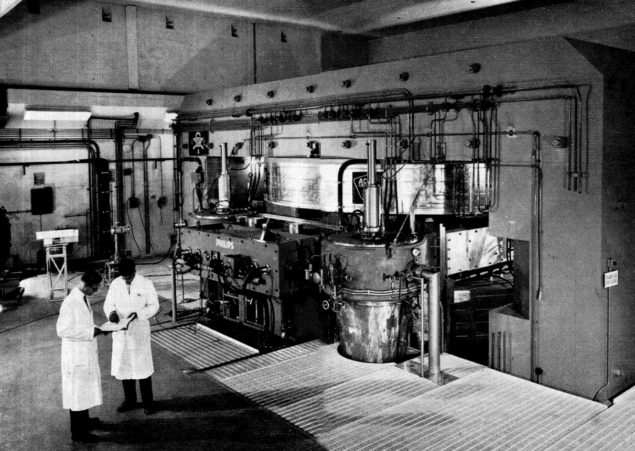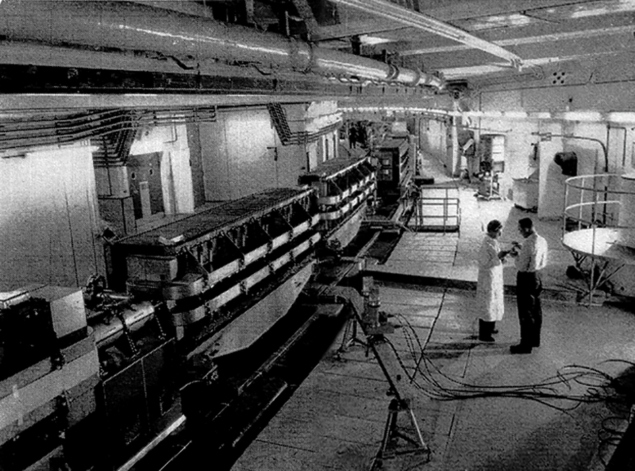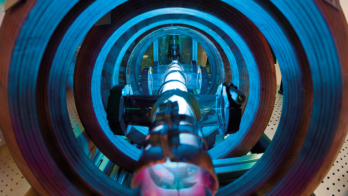In the summer of 1960, the Courier compared and contrasted the 600 MeV Synchrocyclotron (CERN’s first accelerator) and the 28 GeV Proton Synchrotron, which had accelerated its first protons the previous year. The vacuum system was one of several clear differences between these two early machines.

The two particle accelerators built at CERN for studying the structure of matter are called the synchro-cyclotron and the synchrotron. What similarity and what difference is there between these two machines? All accelerators have certain points in common: a source of particles to accelerate; a vacuum tank in which the particles can move without being slowed down too much by air molecules; and a target, internal or external. Like all accelerators, the CERN machines both use electrical phenomena for “pushing” the particles, and a magnetic field to keep them on an almost circular orbit. The synchro-cyclotron and the synchrotron are “circular accelerators” also called “orbital accelerators”. The particles move along curved trajectories. In both CERN machines these particles are protons or nuclei of the hydrogen atom. By and large, the resemblance can be said to end here. There are basic differences in the design of the two machines and in the kinetic energy – or acceleration – which they can impart to the nuclear projectiles.
The synchro-cyclotron
Derived from the cyclotron, which it resembles from outside, the synchro-cyclotron – or SC – gives the accelerated particles a curved trajectory. It forces them repeatedly to cross an accelerating electrode, called a “Dee” because of its shape. The particles are injected 54 times per second from a source in the middle of the vacuum tank. Each accelerating push increases the speed of the proton which, owing to centrifugal force, has a trajectory in the shape of a growing spiral.
The accelerating process lasts a few milliseconds, during which the particles make 150 000 turns in the vacuum tank, covering about 2500 km, and reach 80% of the velocity of light! When the pulsed proton beam reaches the energy at which it is used – a maximum of 600 MeV – i.e. at the circumference of the vacuum tank, there are two ways of using it. The proton beam can be extracted as it is and directed towards the experimental apparatus, or the beam may strike a target inside the vacuum tank; in this way, a source of secondary particles – neutrons or pi mesons – is created and they in turn are directed towards the experimental apparatus.
The photograph above shows the inner sanctum of the SC, the machine room, which no one may enter when the machine is operating.

There one can see the huge structure of the 2500-ton electro-magnet. Its horizontal yoke consists of 18 magnetic steel plates, 11 m long, 1.5 m high and 36 cm thick. The
electro-magnet is excited by two enormous coils. One is clearly visible on the photograph: its aluminium cover can be seen shining at the top of the photograph. The other is placed symmetrically to it but is in the shadow and does not show up so clearly. Each of the coils weighs 55 tons, measures 7.2 m in diameter and consists of 9 pancakes of aluminium conductors measuring 19 cm2 in cross section. There is a 3 cm2 hole in the centre of the conductor for the circulation of 30 000 litres/hour of demineralized cooling water. This is necessary as the exciting current is 1750 amperes d.c. at 400 volts. It was a considerable undertaking to bring these two coils from the factory where they were made in Belgium, by barge up the Rhine and on a special trailer through Switzerland.
The magnetic field set up by the electro-magnet is constant: 18 500 gauss. For the sake of comparison the magnetic field of the earth is 1 gauss, the strongest field which the best anti-magnetic watches can stand is 1000 gauss. The 18 500 gauss field is applied across the vacuum tank between the 5 m diameter poles of the electromagnet – which were forged at Rotterdam and machined at Le Creusot. It “focuses” the accelerated particles on their spiral orbit in the vacuum tank.
The vacuum tank, in which the protons turn, has a cubic capacity of 23 m3 and its stainless steel walls are 60 mm thick. The vacuum in this tank is better than 10–5 mm of mercury, in other words the pressure is 76 million times less than that of the earth’s atmosphere. This vacuum is created and maintained by two large vacuum pumps, one of which is clearly visible in the foreground of the photograph.
The radio-frequency system generates the alternating electric field which accelerates the particles. The frequency decreases from 29.3 to 16.4 Mc/s (millions of cycles per second) as the velocity and mass of the particles increase. The most spectacular part of the system is perhaps the modulator in the shape of a tuning fork, 0.5 m long and 2 m wide, housed in the bulge in the vacuum tank which can be seen to the left of the pump.
The concrete building in which the SC operates is intended to stop radiation. The walls which box in the SC are up to 5.8 m thick and are fitted with two 200-ton doors, which slide slowly into position to block the entrances. The total weight of concrete – standard or with baryte added – is 22 000 tons.
The cost of the synchro-cyclotron ? About twenty-four million Swiss francs, including the buildings. The staff in charge of maintenance, operation and technical development, totals 26, excluding the experimental physicists.
What place does the SC occupy in the world of accelerators? Out of the 18 synchro-cyclotrons now operating, the CERN SC comes third in respect of energy (600 MeV), after the 730 MeV SC at Berkeley in California and the 680 MeV machine at Dubna, in Russia.
The synchrotron
The synchrotron looks quite different from the SC. It is as extensive as the SC is massive and squat.
The PS also curves the trajectory of the particles it accelerates, but the fixed radius of curvature is about 100 m. The protons go through 16 accelerating units, placed at intervals round the 628 m circumference. They are generally injected into the big accelerator’s vacuum tank, once every three seconds, after having gone through a pre-accelerator and a linear accelerator. When they enter the 200 m diameter ring, the particles already have an initial kinetic energy of 50 million electronvolts (MeV). Every time the protons pass through one of the 16 accelerating cavities, their velocity is increased, while a growing magnetic field keeps their trajectory on an orbit of constant radius.
In the PS the acceleration process lasts one second. During this time the particles make some 450 000 turns in the vacuum tank, covering about 300 000 km and reaching 99.94% of the velocity of light.
Once maximum energy – 25 or 28 thousand million electronvolts (GeV) – has been reached, the bunches of particles strike a target in the vacuum tank itself. This produces secondary beams of particles and antiparticles. In 1961, it will be possible to extract the primary proton beam and make use of it; at present, only a small proportion of the protons scattered by the nuclei of the target cross the wall of the vacuum tank and can be used as a high energy proton beam for experiments.

The photograph here was taken in the tunnel – the 200 m diameter ring in which the synchrotron is installed. Of course, nobody is allowed in the ring when the machine is operating, because of the radiation danger.
The electro-magnet consists of 100 separate units placed right round the circumference. Each unit weighs 28.7 tons net and consists of ten C-shaped blocks made up of laminations 1.5 mm thick. Each of the 100 units is excited by two coils placed longitudinally on the pole pieces of the units. Each coil consists of two pancakes, each with 5 windings of aluminium conductor 21 cm2 in cross-section; this conductor is hollow to let cooling water through since the current can reach 6400 amperes at 5400 volts.
The magnetic field produced varies from 147 gauss when the particles are injected into the synchrotron to 12 000 or 14 000 gauss when they have been fully accelerated. The magnetic field is applied across the vacuum tank, a long elliptical tube with a cross-section of 14 × 7 cm, curving round the 628 m circumference of the machine between the poles of the 100 magnet units. The walls of the tank are made of stainless steel, in order to be unaffected by the magnetic field and are only 2 mm thick. A vacuum better than 10-5 mm of mercury is maintained in the tank by 66 pumps on the outer edge of the ring and 5 others in the injection system.
In each accelerating cavity, the radio-frequency system creates the alternating electric field which accelerates the protons. As we have seen in the SC, the applied radio-
frequency has to decrease in order to keep in step with particles which take more and more time to go round as the orbit expands; in the PS, on the other hand, the orbit is constant and the ever-increasing velocity of the particles calls for an increase in frequency from 2.9 to 9.55 M c/s.
The ring-shaped concrete building which contains the PS is buried underground as an additional protection against gamma and fast neutron radiation: the 40 cm of concrete walls are covered with more than 3 m of earth and stones.
There are no gigantic doors here as in the SC: a zigzag passage is used to stop radiation, while giving access to the machine when it is not operating. When it is in operation, a whole network of electric connections would stop the accelerator if anyone, regardless of the danger, tried to gain access to it by forcing one of the locked doors. The level of radio-activity is probably more intense between the two experimental halls – north and south – because of the presence of the targets. There the ceiling of the funnel is made of 2 m of special baryte concrete with a density of 3.5 t/m3. There is a series of movable blocks in the walls so that openings can be made as required for admitting the beams into the experimental halls.
The synchrotron cost 120 million Swiss francs: ten cigarettes for each of the 220 million inhabitants of CERN’s twelve Member States.
The “Machine Group” in charge of exploiting and developing the PS is a team of 139. The actual running of the machine needs ten operators.
As for the position of the PS with respect to other accelerators, the CERN synchrotron comes second in the world with 28 GeV, after the 31 GeV synchrotron commissioned at Brookhaven on 30 July.
- This article was adapted from text in CERN Courier vol. 1, September 1960, pp6–8





